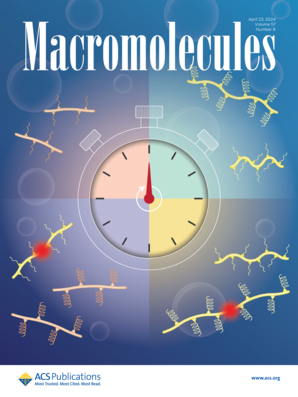Flow-Induced Reduction of the Monomeric Friction Coefficient Using a Branched Environment in Linear Isotactic Polypropylene Melt
IF 5.1
1区 化学
Q1 POLYMER SCIENCE
引用次数: 0
Abstract
In this work, the effect of the stretch Weissenberg number, WiR, on the monomeric friction coefficient is investigated for three entangled linear isotactic polypropylenes (L-PP) and three entangled long-chain branched polypropylene miscible blends (LCB-PP), both groups of polymer melts with a comparable range of the number of Kuhn segments of the whole chain, the number of Kuhn segments between entanglements, the number of entanglements per chain, and the polydispersity index, via free volume measurements using the Williams–Landel–Ferry equation and temperature-dependent high-strain rate rheology (covering the extensional strain rate range of 2 × 104 1/s to 2 × 106 1/s at a Hencky strain of 6.8) via entrance pressure drop measurements in an abrupt contraction flow using the Gibson method. The ratio of the equilibrium monomeric friction coefficient defined by Doi and Edwards, ζeq, to the monomeric friction coefficient for fully aligned chains due to strong uniaxial extensional flow, ζaligned, was found to increase in the following order: L-PPs (5.234 ± 0.8489) < 10 wt % LCB-PP blend 64k (6.249 ± 0.3950) < 20 wt % LCB-PP blend 70k (8.061 ± 0.1851) < 30 wt % LCB-PP blend 78k (11.104 ± 0.8995). The presence of a high-molecular-weight branched environment in low-molecular-weight linear PPs caused a more intense decrease in the monomeric friction coefficient (due to the increased free volume indicating a higher coalignment ability of the macromolecules in the LCB-PP blends compared to that of pure linear PP macromolecules), leading to a decrease in the Trouton ratio at WiR, in which the polymer chains become fully aligned.

支化环境下线性等规聚丙烯熔体中单体摩擦系数的流动诱导降低
本文研究了三种纠缠的线性等规聚丙烯(L-PP)和三种纠缠的长链支化聚丙烯共混物(LCB-PP)的拉伸Weissenberg数(WiR)对单体摩擦系数的影响,这两种聚合物熔体在整个链的库恩段数、缠结之间的库恩段数、每链的缠结数和多分散指数等方面具有相当的范围。通过使用Williams-Landel-Ferry方程和温度相关的高应变率流变学(覆盖2 × 104 1/s至2 × 106 1/s的拉伸应变速率范围,Hencky应变为6.8)通过使用Gibson方法在突然收缩流动中测量入口压降进行自由体积测量。Doi和Edwards定义的平衡单分子摩擦系数(ζeq)与强单轴拉伸流引起的完全排列链的单分子摩擦系数(ζaligned)的比值依次增大:L-PPs(5.234±0.8489)<;10 wt % LCB-PP共混64k(6.249±0.3950);LCB-PP共混物70k(8.061±0.1851)<;30 wt % LCB-PP共混78k(11.104±0.8995)。低分子量线性PP中存在高分子量支链环境,导致单体摩擦系数下降更剧烈(由于自由体积增加,表明LCB-PP共混物中的大分子与纯线性PP大分子相比具有更高的共配能力),导致WiR时Trouton比下降,此时聚合物链完全对齐。
本文章由计算机程序翻译,如有差异,请以英文原文为准。
求助全文
约1分钟内获得全文
求助全文
来源期刊

Macromolecules
工程技术-高分子科学
CiteScore
9.30
自引率
16.40%
发文量
942
审稿时长
2 months
期刊介绍:
Macromolecules publishes original, fundamental, and impactful research on all aspects of polymer science. Topics of interest include synthesis (e.g., controlled polymerizations, polymerization catalysis, post polymerization modification, new monomer structures and polymer architectures, and polymerization mechanisms/kinetics analysis); phase behavior, thermodynamics, dynamic, and ordering/disordering phenomena (e.g., self-assembly, gelation, crystallization, solution/melt/solid-state characteristics); structure and properties (e.g., mechanical and rheological properties, surface/interfacial characteristics, electronic and transport properties); new state of the art characterization (e.g., spectroscopy, scattering, microscopy, rheology), simulation (e.g., Monte Carlo, molecular dynamics, multi-scale/coarse-grained modeling), and theoretical methods. Renewable/sustainable polymers, polymer networks, responsive polymers, electro-, magneto- and opto-active macromolecules, inorganic polymers, charge-transporting polymers (ion-containing, semiconducting, and conducting), nanostructured polymers, and polymer composites are also of interest. Typical papers published in Macromolecules showcase important and innovative concepts, experimental methods/observations, and theoretical/computational approaches that demonstrate a fundamental advance in the understanding of polymers.
 求助内容:
求助内容: 应助结果提醒方式:
应助结果提醒方式:


